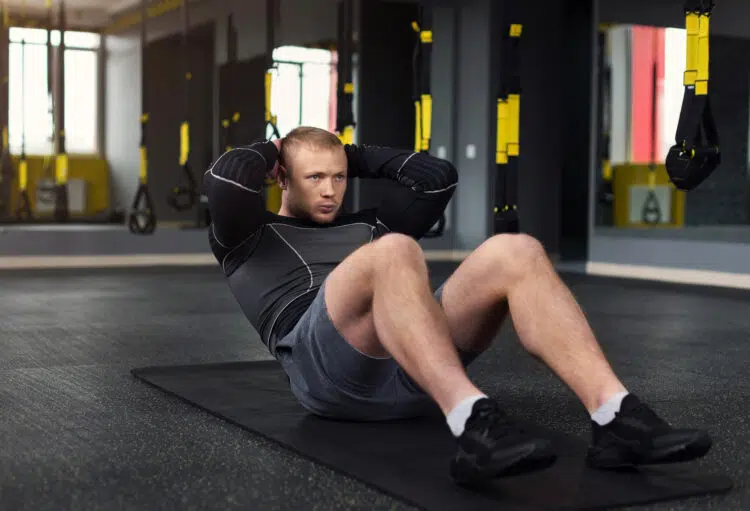Your core muscles (abs, obliques, diaphragm, pelvic floor, erector spinae, glutes, and lats) are the foundation of your body. Strong core muscles can help improve your training performance and overall functionality in everyday tasks, from overhead pressing a heavy weight to carrying groceries.
Even though I had been training for over 17 years, I didn’t ever pay much attention to targeted core and ab training.
This oversight has resulted in noticeable weaknesses, which are evident during exercises like overhead dumbbell tricep extension and overhead squats, where my midline trembles like we’re in the middle of an earthquake.
I decided to fix this and programmed an intense ab workout challenge that involved doing 10, 50, and 100 sit-ups every morning. The initial part of this challenge was designed to allow my body time to adapt to the new training protocol.
In this article, I share all the details of this 30-day challenge sit-up challenge, including the impacts on my core strength, posture, and overall physique.
How To Perform Sit-ups
Level Up Your Fitness: Join our 💪 strong community in Fitness Volt Newsletter. Get daily inspiration, expert-backed workouts, nutrition tips, the latest in strength sports, and the support you need to reach your goals. Subscribe for free!
Many people use ‘sit-ups’ and ‘crunches’ interchangeably. However, these exercises involve different ranges of motion (ROM) and target the midline uniquely.
Sit-ups involve lifting your entire torso off the ground until you are sitting upright. On the other hand, crunches comprise elevating the upper back and shoulder off the ground while the lower back stays on the floor. The former exercise biases the abdominals, hip flexors, chest, lower back, and neck, whereas the latter primarily targets the rectus abdominis and obliques.
Before we get into the nitty-gritty of my 30-day challenge, let’s talk about how to perform sit-ups with the perfect form to maximize the results while limiting injury risk:
- Lie supine with your knee flexed and feet flat on the floor.
- Place your hands beside your ears. Avoid interlocking your fingers behind your head and using your arms to generate torque, as it can strain the neck.
- Contract your core and use your abs to lift your upper back and shoulders off the floor. Breathe out during this phase.
- Your upper body should be almost perpendicular at the top. Avoid sitting upright, as it can remove the tension from the abs.
- Return to the starting position using a slow and controlled motion.
- Initiate the next rep as soon as your upper back touches the floor.
Coach Tip: Anchor your ankles under a sturdy surface to prevent your feet from rising off the floor during the concentric phase.
My 30-Day Sit-Up Challenge Progression Plan
As I said in the opening of this article, I have a relatively weak core.
I knew doing 100 sit-ups from Day One would do more harm than good, so I cooked up a four-week progression plan for optimal gains and recovery. Since 30 days is a short time, I didn’t take any days off. Plus, I did my regular strength training workouts in the evening.
Here is the 30-day sit-up plan:
| Days | Sets | Reps | Total Reps |
| 1-7 | 1 | 10 | 10 |
| 8-14 | 3 | 20, 15, 15 | 50 |
| 15-21 | 3 | 40, 30, 30 | 100 |
| 22-30 | 2 | 50, 50 | 100 |
I did these sit-ups right after using the loo. This approach ensured I couldn’t come up with any excuses to skip the workouts.
I wanted to ease into this challenge, so I only did 10 sit-ups for the first seven days. The second week made me feel more confident about my abilities, and I decided to aim for 100 sit-ups in the third week itself. I had initially planned to do 100 sit-ups in the final week.
I must add that going from 50 to 100 reps felt like a much bigger jump than moving from 10 to 50 reps, although the relative volume increase was much higher in the second week.
Take the sets and reps I have mentioned for the final phase with a grain of salt. Although I intended to do two sets of 50 reps each, there were days when I was overly fatigued and hit the 100-rep mark in three to four sets.
What Happens When You Do 10 Sit-ups Every Morning
Now that you know my starting fitness level and progression plan, let’s talk about the results of this 30-day challenge.
Although I would call myself a core training beginner, the first phase of this challenge was relatively easy — as it was supposed to be. I flew through the 10 reps each morning, and to be honest, the results were more psychological than they were physiological.
Since this was a relatively small number of reps, it allowed me to drill the movement mechanics and ensure maximum core activation.
By the end of the first week, I was confident that I could see this challenge through.
Sticking to this challenge for the first seven days also felt like I was over the hump. With the schedule locked in, it was now all about doing the remaining 1,950 reps with the perfect form. Yep, that’s how many sit-up reps I performed in 23 days.
Stepping it Up: 50 Sit-ups Every Morning

The first day of the second week was a big shock. I had originally thought I could do the stipulated 50 reps in a couple of sets. However, I got a reality check in the first set itself when I struggled to complete 20 reps.
I broke the 50 reps into three sets. Saying that I had insane ab delayed onset muscle soreness (DOMS) on the third day of this phase would be an understatement.
Level Up Your Fitness: Join our 💪 strong community in Fitness Volt Newsletter. Get daily inspiration, expert-backed workouts, nutrition tips, the latest in strength sports, and the support you need to reach your goals. Subscribe for free!
The soreness was so intense that I had trouble changing sides at night, and sneezing felt like a curse.
But the good news is that I started noticing an improvement in my abdominal muscle thickness and depth. Research also shows that doing sit-ups regularly can help alleviate lower back pain and improve trunk stabilization. (1)
Doing 50 sit-ups a day is a significant challenge for your core muscles, irrespective of your training experience. It can help improve your core endurance and strength, boosting your performance in compound exercises and daily functionality. (2)
A powerful core can boost your athletic performance across various disciplines. Swimmers, runners, grapplers, and even weightlifters should all prioritize ab training.
Going All-In: 100 Sit-ups Every Morning
Transitioning from 50 to 100 sit-up reps is easier said than done. You can only understand the magnitude of 100 sit-ups when you perform them yourself.
The most challenging part of this phase was that I had 16 days of doing 100 sit-ups daily. I won’t lie; there were days when I felt I had bitten off more than I could chew. My ab soreness was so high I could barely scoot up in my work chair.
By the end of the third week, my ab fatigue and soreness were so high it impaired my recovery.
Week Four started with what I had been fearing all along — ab cramps. If you have ever experienced ab cramps, you’d agree they are the worst.
I took Tuesday off in the fourth week to allow my midline time to recuperate. I ensured I hit my macronutrient and hydration goals to speed up recovery. This approach paid off, as I felt much better the next day and could resume the challenge.
My core felt much stronger and more stable than ever. I felt in total control during overhead exercises and squats during the final stretch of this challenge, which indicated that I was moving in the right direction.
A scientific review highlights that core stability exercises like sit-ups can enhance athletic performance, help prevent injuries, and improve posture. This suggests that a strong core is essential for efficient movement and maintaining proper body alignment. (3)
An Unexpected Benefit
Although I knew about the core strength, postural, and aesthetic benefits of doing sit-ups daily, I had no idea it would rev up my metabolism as it did. This helped me burn more calories throughout the day, resulting in a chiseled midsection.
Potential Drawbacks and Considerations of the Daily Sit-Up Challenge
Although a daily sit-up practice can help you unlock new gains, it has its fair share of drawbacks, including:
Risk of Overuse Injuries
Doing 50 to 100 daily sit-ups can take its toll on your body. While most intermediate and advanced exercisers should be able to complete this challenge without any hiccups, newer athletes must pay close attention to how their bodies respond to the stimulus.
Learn to listen to your body, and feel free to lower the training volume or take a few days off to avoid overuse injuries.
Muscle and Strength Imbalances
If you are going to be performing sit-ups daily, you must reevaluate your entire training regime. Make sure you are not overlooking any other muscle groups. Remember, fixing strength and muscle imbalances can take a long time. It’s much better to avoid them.
Plateaus
Sticking to the same training volume for an extended period can lead to strength and muscle plateaus. Program progressive overload into your schedule to avoid hitting an overhead ceiling. Doing more reps in a single set, resting for shorter duration between sets, and using additional resistance are a few ways to overload the core during sit-ups.
Nutritional Needs
Folks who are looking to try this 30-day ab challenge must remember that building a sculpted core with a visible six-pack demands a balanced diet and a calorie deficit to shed excess body fat.
Although I won’t be doing sit-ups daily anymore, I have made them a constant in my training regime, considering the benefits I cultivated from this challenge.
Conclusion
Sit-ups are a foundational core exercise that engages multiple muscles, contributing to core strength development, posture improvement, and overall physique aesthetics enhancement. (4)
Beginners should ideally start their daily sit-up journey with 10 percent of their final goal repetitions. Increase the volume gradually to allow your muscles time to adapt to the greater demands.
Ensure that you are following the correct form to maximize the results while limiting injury risk. Stick to this regime long enough, and you’ll be rewarded with some mind-blowing results.
If you have any questions about sit-ups and their benefits or need help implementing them into your routine, post them in the comments below, and I’ll be happy to help!
References:
- Lee JS, Kim TH, Kim DY, Shim JH, Lim JY. Effects of selective exercise for the deep abdominal muscles and lumbar stabilization exercise on the thickness of the transversus abdominis and postural maintenance. J Phys Ther Sci. 2015;27(2):367-370. doi:10.1589/jpts.27.367
- Vispute, S. S., Smith, J. D., LeCheminant, J. D., & Hurley, K. S. (2011). The effect of abdominal exercise on abdominal fat. Journal of strength and conditioning research, 25(9), 2559–2564. https://doi.org/10.1519/JSC.0b013e3181fb4a46
- Akuthota, V., Ferreiro, A., Moore, T., & Fredericson, M. (2008). Core stability exercise principles. Current sports medicine reports, 7(1), 39–44. https://doi.org/10.1097/01.CSMR.0000308663.13278.69
- Silva, G. B., Morgan, M. M., Gomes de Carvalho, W. R., Silva, E., de Freitas, W. Z., da Silva, F. F., & de Souza, R. A. (2015). Electromyographic activity of rectus abdominis muscles during dynamic Pilates abdominal exercises. Journal of bodywork and movement therapies, 19(4), 629–635. https://doi.org/10.1016/j.jbmt.2014.11.010










